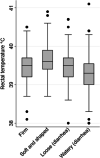An observational field study of porcine post-weaning diarrhea: clinical and microbiological findings, and fecal pH-measurements as a potential diagnostic tool
- PMID: 37434248
- PMCID: PMC10334583
- DOI: 10.1186/s40813-023-00325-x
An observational field study of porcine post-weaning diarrhea: clinical and microbiological findings, and fecal pH-measurements as a potential diagnostic tool
Abstract
Background: Recently, in-feed medicinal zinc has been phased out in pig production in the European Union. This makes updated knowledge about porcine post-weaning diarrhea (PWD) crucial. The objectives of the present study were to investigate (i) the clinical presentation of PWD in pigs housed in Danish herds that did not use medicinal zinc, specifically the prevalence of diarrhea and whether PWD was associated to clinical signs of dehydration or altered body temperature; (ii) which microorganism are associated to PWD; and iii) whether measurements of the fecal pH have a potential to be used diagnostically to differentiate between infectious etiologies in cases of PWD.
Results: The prevalence of diarrhea varied considerably between the outbreaks in the nine studied herds (median = 0.58, range = 0.10; 0.94). In a cross-sectional design (n = 923), diarrhea was associated with reduced rectal temperature and alkaline feces. Diarrhea was also associated with observably reduced skin elasticity, possibly indicating dehydration. In both diarrheic case pigs (n = 87) and control pigs (n = 86), the presence of Brachyspira pilosicoli, Clostridium perfringens, Cryptosporidium spp., Cystoisopora suis, enterotoxigenic Escherichia coli, Lawsonia intracellularis, porcine circovirus types 2 and 3, rotavirus A, B, C, and H, Samonella enterica spp. enterica, and Trichuris suis was described. PWD was associated with high levels of enterotoxigenic E. coli shedding (odds ratio versus no E. coli detection = 4.79 [CI 1.14; 12.62]). Diarrhea was associated with high levels of rotavirus A shedding (odds ratio versus no/low rotavirus A = 3.80 [CI 1.33; 7.97]). The association between microbiological findings in diarrheic pigs and fecal pH was negligible.
Conclusions: Enterotoxigenic E. coli was confirmed to be a cause of PWD; however, cases of PWD where enterotoxigenic E. coli was not detected in high levels occurred commonly, and this adds to the increasing evidence suggesting that PWD is not necessarily a result of enteric colibacillosis. Rotaviral enteritis might be a differential diagnosis of PWD. pH-measurements cannot be used to differentiate between differential diagnoses for PWD.
Keywords: Enterotoxigenic Escherichia coli; Pig; Post-weaning diarrhoea; Rectal temperature; Rotavirus; pH.
© 2023. The Author(s).
Conflict of interest statement
The authors’ past and present research projects are frequently funded by Danish authorities regulating the pig production and the Danish pork industry through different sources. The authors believe that this has not inappropriately influenced the present work.
Figures







Similar articles
-
Post-weaning diarrhea in pigs weaned without medicinal zinc: risk factors, pathogen dynamics, and association to growth rate.Porcine Health Manag. 2021 Oct 9;7(1):54. doi: 10.1186/s40813-021-00232-z. Porcine Health Manag. 2021. PMID: 34627400 Free PMC article.
-
Prevalences and excretion levels of Lawsonia intracellularis, Brachyspira pilosicoli and Escherichia coli F4 and F18 in fecal sock samples from Danish weaner and finisher pig batches and the association with diarrhea.Porcine Health Manag. 2022 Oct 28;8(1):44. doi: 10.1186/s40813-022-00290-x. Porcine Health Manag. 2022. PMID: 36307895 Free PMC article.
-
Post-weaning diarrhea in pigs from a single Danish production herd was not associated with the pre-weaning fecal microbiota composition and diversity.Front Microbiol. 2023 Feb 24;14:1108197. doi: 10.3389/fmicb.2023.1108197. eCollection 2023. Front Microbiol. 2023. PMID: 36922976 Free PMC article.
-
Post weaning diarrhea in pigs: risk factors and non-colistin-based control strategies.Acta Vet Scand. 2017 May 19;59(1):31. doi: 10.1186/s13028-017-0299-7. Acta Vet Scand. 2017. PMID: 28526080 Free PMC article. Review.
-
Intestinal challenge with enterotoxigenic Escherichia coli in pigs, and nutritional intervention to prevent postweaning diarrhea.Anim Nutr. 2017 Dec;3(4):322-330. doi: 10.1016/j.aninu.2017.10.001. Epub 2017 Oct 14. Anim Nutr. 2017. PMID: 29767133 Free PMC article. Review.
Cited by
-
Metallo-Glycodendrimeric Materials against Enterotoxigenic Escherichia coli.Microorganisms. 2024 May 11;12(5):966. doi: 10.3390/microorganisms12050966. Microorganisms. 2024. PMID: 38792795 Free PMC article.
-
The cotton swab method: an accurate and less invasive way to assess fecal consistency in weaned pigs.BMC Vet Res. 2024 Feb 3;20(1):47. doi: 10.1186/s12917-024-03888-1. BMC Vet Res. 2024. PMID: 38310282 Free PMC article.
-
A Systematic Review: Is Porcine Kobuvirus Causing Gastrointestinal Disease in Young Pigs?Vet Sci. 2023 Apr 11;10(4):286. doi: 10.3390/vetsci10040286. Vet Sci. 2023. PMID: 37104441 Free PMC article. Review.
-
A Virus-like Particle-Based F4 Enterotoxigenic Escherichia coli Vaccine Is Inhibited by Maternally Derived Antibodies in Piglets but Generates Robust Responses in Sows.Pathogens. 2023 Nov 24;12(12):1388. doi: 10.3390/pathogens12121388. Pathogens. 2023. PMID: 38133272 Free PMC article.
-
Control of Neonatal Diarrhea in Piglets with Reduced Antibiotic Use by Application of a Complementary Feed-A Randomized Controlled Farm Trial.Vet Sci. 2025 Jan 10;12(1):42. doi: 10.3390/vetsci12010042. Vet Sci. 2025. PMID: 39852918 Free PMC article.
References
-
- DANMAP. DANMAP 2017 - Use of antimicrobial agents and occurrence of antimicrobial resistance in bacteria from food animals, food and humans in Denmark [Internet]. 2018. Available from: https://www.danmap.org/-/media/arkiv/projekt-sites/danmap/danmap-reports....
LinkOut - more resources
Full Text Sources
Miscellaneous

